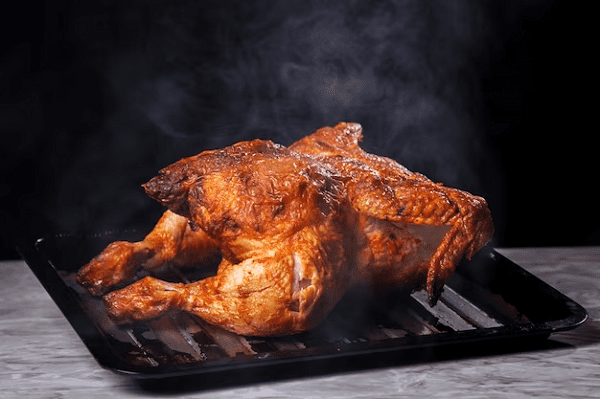Chicken- Chicken is a popular domesticated bird and a common source of poultry meat worldwide. Here are some key facts about chickens:
- Species: The domestic chicken, known scientifically as Gallus gallus domesticus, is a subspecies of the red junglefowl (Gallus gallus) native to Southeast Asia.
- Domestication: Chickens have been domesticated for thousands of years, with origins in Asia. They were primarily raised for their meat and eggs.
- Varieties: There are many different breeds of chickens, each with its own characteristics, appearance, and purpose. Some common breeds include the Rhode Island Red, Leghorn, and Plymouth Rock.
- Meat and Eggs: Chickens are primarily raised for their meat (broilers) and eggs (layers). The meat from chickens is a staple in many diets, and eggs are used in a wide variety of culinary dishes.
- Lifespan: The average lifespan of a chicken can vary depending on its purpose. Broiler chickens are typically raised for about 6-7 weeks before being processed for meat, while laying hens can live for several years.
- Behavior: Chickens are social birds that often live in flocks. They have a hierarchical structure within the flock, with a dominant rooster and pecking order among hens.
- Reproduction: Hens lay eggs, which can be fertilized by a rooster if one is present. The incubation period for chicken eggs is about 21 days, after which chicks hatch.
- Diet: Chickens are omnivores and eat a wide range of foods, including grains, seeds, insects, and even small vertebrates. Commercially raised chickens are typically fed a balanced diet to ensure their health and growth.
- Health and Care: Proper care is essential to keep chickens healthy. This includes providing clean water, adequate shelter, and protection from predators. Vaccinations and preventive measures are also used in commercial poultry farming.
- Economic Importance: Chickens are a significant source of food and income for many people around the world. The poultry industry is a major contributor to the global food supply.
Chickens are not only valued for their role in food production but are also kept as pets in some cultures, and they play a role in various cultural and religious traditions.
What is Chicken
“Chicken” can refer to two different things:
- Poultry Meat: Chicken is a type of meat that comes from domesticated chickens (Gallus gallus domesticus). It’s one of the most common and widely consumed meats in the world. Chicken meat can be prepared in various ways, such as grilling, frying, roasting, and stewing. It is a versatile and popular source of protein in many cuisines.
- The Bird Itself: “Chicken” can also refer to the domesticated bird that provides the meat and eggs. Chickens are kept for various purposes, including meat production (broilers) and egg production (layers). They come in various breeds with different characteristics, appearances, and productivity levels.
In everyday language, “chicken” is often used interchangeably to describe both the bird and its meat, depending on the context.
Who is Required Chicken
The term “Chicken” on its own typically does not refer to a specific individual, person, or character. It’s a common name for the domesticated bird, Gallus gallus domesticus, as well as the meat that comes from this bird. However, if you are asking about a specific individual or character named “Chicken,” please provide more context or details, and I’ll do my best to assist you further.
Where is Required Chicken

“Chicken” can refer to both the domesticated bird and its meat, but it’s not a specific location or place. Chickens are raised and found in many parts of the world, typically on farms or in rural and suburban areas. The distribution of chickens is global, and they are raised in various countries for their meat and eggs. If you have a more specific question about the location of chickens or are looking for information about a particular place, please provide additional context, and I’ll do my best to assist you.
How is Required Chicken
“Chicken” can refer to the domesticated bird, Gallus gallus domesticus, as well as the meat that comes from this bird. If you are asking about the bird itself, here’s some information on how chickens are:
- Physical Characteristics: Chickens have feathers, a beak, two legs, and a comb on top of their head. They come in various colors and feather patterns, depending on their breed.
- Habitat: Chickens are typically kept in coops or on farms. They are domesticated birds and are raised in various regions around the world.
- Diet: Chickens are omnivores and eat a diet that consists of grains, seeds, insects, and small invertebrates. They may also be provided with commercial poultry feed in controlled environments.
- Behavior: Chickens are social birds and often live in flocks. They have a pecking order within the flock, with dominant and subordinate individuals.
- Reproduction: Hens lay eggs, which can be fertilized by roosters if they are present. These eggs can be incubated to hatch chicks.
If you have a specific question about how chickens are raised, their behavior, or any other aspect of chickens, please provide more specific details, and I’ll be happy to provide further information.
Case Study on Chicken
Creating a case study on a specific aspect of chicken production or the poultry industry can be quite comprehensive, depending on your focus. Below is a hypothetical case study focusing on the sustainability and environmental impact of a large-scale chicken production operation:
Title: Sustainable Practices in Large-Scale Chicken Production
Introduction: The poultry industry is one of the fastest-growing sectors in agriculture, driven by the increasing demand for chicken meat and eggs. This case study explores a large-scale chicken production operation that has implemented sustainable practices to reduce its environmental impact while maintaining profitability.
Background: The case study focuses on “Green Acres Poultry Farm,” a commercial chicken farm located in the Midwest of the United States. The farm has been in operation for over two decades and has 250,000 broiler chickens at any given time.
Objectives:
- To examine the sustainable practices implemented by Green Acres Poultry Farm.
- To assess the environmental impact and economic viability of these practices.
- To analyze the challenges and benefits of sustainable chicken production.
Methods:
- Data Collection: Information was collected through interviews with the farm’s management and workers, on-site visits, and reviewing their operational records.
- Environmental Impact Assessment: The study evaluated water usage, waste management, energy consumption, and the farm’s carbon footprint.
- Economic Analysis: The financial aspects of sustainable practices, including costs and benefits, were assessed.
Sustainable Practices: Green Acres Poultry Farm implemented several sustainable practices:
- Water Recycling: The farm recycles water from the poultry house for irrigation and cooling, reducing water consumption.
- Waste Management: Chicken litter and waste are converted into organic fertilizer and sold to local farmers, reducing waste disposal costs.
- Energy Efficiency: LED lighting, improved insulation, and energy-efficient equipment reduce energy consumption.
- Alternative Feeding: The farm experimented with alternative feed sources, such as insect-based feeds, to reduce reliance on soy and corn.
Environmental Impact:
- Water Use: The water recycling system reduced water consumption by 30%.
- Waste Reduction: Effective waste management cut waste disposal costs by 40%.
- Energy Efficiency: Energy consumption decreased by 15%.
- Carbon Footprint: Green Acres reduced its carbon emissions by 20%.
Economic Analysis: The initial investment in sustainable practices led to increased operational costs. However, these costs were offset by:
- Reduced waste disposal fees.
- Energy cost savings.
- Additional revenue from selling organic fertilizer.
- The farm’s ability to command a premium for sustainably produced chicken meat.
Challenges:
- Initial Capital Investment: The transition to sustainable practices required a substantial upfront investment.
- Adaptation Period: Workers needed time to adjust to the new methods.
- Market Perceptions: Although the farm could command premium prices, consumer perceptions of sustainability needed to be considered.
Conclusion: Green Acres Poultry Farm’s commitment to sustainable practices has resulted in reduced environmental impact, cost savings, and a competitive edge in the market. While initial investments and adaptation were challenges, the long-term benefits justify these efforts. The case study illustrates the potential for large-scale chicken production to be more sustainable without compromising profitability.
Recommendations:
- Encourage subsidies or incentives for poultry farms to adopt sustainable practices.
- Promote consumer education on the benefits of sustainably produced poultry products.
- Share best practices with the industry to encourage widespread adoption of sustainable methods.
This case study highlights the importance of sustainable practices in large-scale chicken production and how they can lead to both environmental and economic benefits.
White paper on Chicken
Title: Sustainable Practices in Poultry Farming
Table of Contents:
- Abstract
- A brief summary of the white paper’s content and key findings.
- Introduction
- An overview of the poultry industry’s significance.
- The need for sustainable practices in poultry farming.
- Challenges in Poultry Farming
- Addressing issues like resource consumption, waste management, and environmental impact.
- Sustainable Poultry Farming Practices
- A detailed exploration of various sustainable practices in poultry farming:
- Water management and conservation.
- Waste reduction and management.
- Energy efficiency.
- Alternative feeding options.
- Animal welfare considerations.
- A detailed exploration of various sustainable practices in poultry farming:
- Environmental and Economic Benefits
- An analysis of the environmental impact and cost-effectiveness of sustainable practices.
- Reduction of carbon footprint.
- Waste management and resource efficiency.
- Economic advantages of sustainable poultry farming.
- Case Studies
- Showcase examples of poultry farms successfully implementing sustainable practices.
- Discuss the results and outcomes of these practices.
- Consumer Awareness and Demand
- Explore the increasing consumer interest in sustainably produced poultry products.
- Discuss the importance of transparency in the supply chain.
- Regulatory Framework and Industry Standards
- Overview of regulations and certifications related to sustainable poultry farming.
- The role of government agencies and industry associations.
- Challenges and Solutions
- Address common challenges in adopting sustainable practices.
- Discuss potential solutions and best practices.
- Future Trends
- Explore emerging trends and innovations in sustainable poultry farming.
- Technology-driven solutions.
- Market shifts and consumer preferences.
- Conclusion
- Summarize the importance of sustainable practices in poultry farming.
- Reinforce the benefits for the environment, businesses, and consumers.
- Recommendations
- Provide actionable recommendations for poultry farmers, policymakers, and consumers.
- Encourage collaboration and knowledge sharing within the industry.
- References
- Cite all the sources and references used in the white paper.
Appendices (if necessary)
- Additional data, charts, and supplementary information.
Glossary
- Definitions of key terms and concepts used in the white paper.
Author Information
- Information about the organization or author responsible for the white paper.
This white paper provides an in-depth examination of sustainable practices in poultry farming, highlighting the benefits, challenges, and potential solutions for stakeholders in the industry. It also underscores the importance of sustainable poultry farming in meeting the growing demand for poultry products while minimizing environmental impact.
Industrial Application of Chicken
The industrial application of chickens primarily revolves around poultry farming and the production of chicken meat and eggs. The poultry industry is a significant sector with various industrial applications, including:
- Broiler Farming: Broilers are chickens raised for meat production. The industrial-scale production of broiler chickens involves large farms with controlled environments, automated feeding and watering systems, and biosecurity measures to ensure healthy and efficient growth.
- Layer Farming: Layers are chickens bred for egg production. Industrial-scale layer farming includes specialized facilities with automated egg collection, climate control, and high-yield chicken breeds.
- Egg Processing: Industrial egg processing plants handle and package eggs for distribution to retailers and food manufacturers. They may produce various egg products, including liquid eggs, pasteurized eggs, and egg powders.
- Feed Production: The poultry industry relies on the production of feed tailored to the nutritional needs of chickens. Feed mills create customized feed formulations, incorporating grains, proteins, vitamins, and minerals.
- Hatcheries: Commercial hatcheries produce chicks for both broiler and layer farms. These facilities use advanced incubation technology to ensure the development of healthy chicks.
- Slaughter and Processing: Chicken processing plants handle the slaughtering, processing, and packaging of chicken meat. These facilities are highly automated and implement strict quality control measures.
- By-Products Utilization: Various by-products from chicken processing, such as feathers, blood, and offal, have industrial applications. Feathers can be used in the production of feather meal or as a source of keratin for cosmetics and fertilizers.
- Manure Management: Poultry farms generate substantial amounts of manure. In some cases, this waste is treated and converted into organic fertilizers or used in biogas production for energy.
- Biotechnology and Genetics: Genetic selection and biotechnology play a role in developing chicken breeds with desired traits, such as higher meat yield or disease resistance.
- Vaccines and Pharmaceuticals: The poultry industry relies on vaccines and pharmaceuticals to maintain the health and well-being of chickens, preventing and treating diseases.
- Equipment Manufacturing: The manufacturing of specialized equipment for poultry farming, such as feeders, drinkers, incubators, and climate control systems, is a significant industry in itself.
- Retail and Food Service: Chicken products reach consumers through retail stores and foodservice outlets, including fast-food chains and restaurants.
- Research and Development: Ongoing research in the poultry industry focuses on improving production efficiency, animal welfare, and sustainability through advances in genetics, nutrition, and management practices.
- Export and Trade: Chicken meat and eggs are globally traded commodities. International trade involves large-scale industrial operations for processing and packaging to meet import/export requirements.
- Sustainability Practices: The industry is increasingly adopting sustainable practices, such as reducing resource consumption, waste management, and the responsible use of antibiotics.
The industrial application of chickens is a crucial part of the global food supply chain. It involves various sectors, technologies, and practices to meet the growing demand for poultry products while addressing environmental and sustainability challenges.





